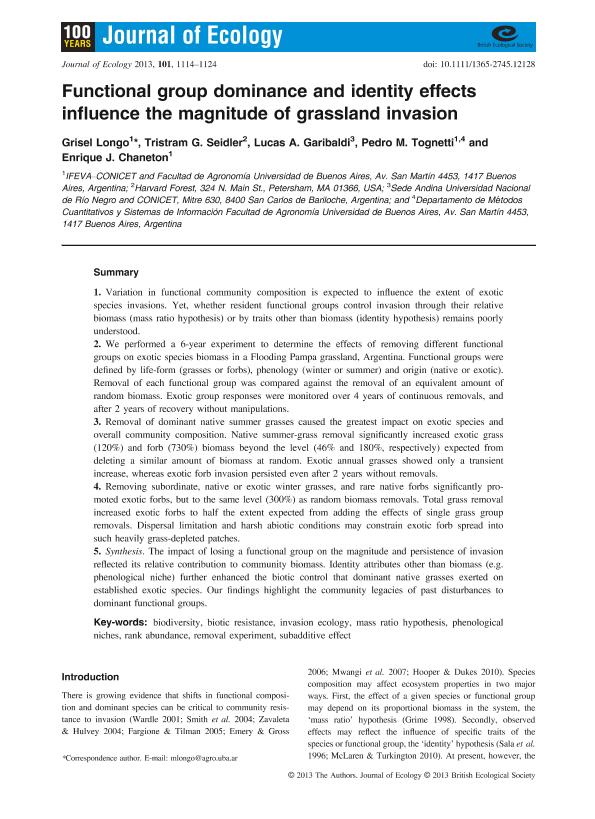Mostrar el registro sencillo del ítem
dc.contributor.author
Longo, Maria Grisel

dc.contributor.author
Seidler, Tristram G.
dc.contributor.author
Garibaldi, Lucas Alejandro

dc.contributor.author
Tognetti, Pedro Maximiliano

dc.contributor.author
Chaneton, Enrique Jose

dc.date.available
2016-02-17T21:06:19Z
dc.date.issued
2013-09
dc.identifier.citation
Longo, Maria Grisel; Seidler, Tristram G.; Garibaldi, Lucas Alejandro; Tognetti, Pedro Maximiliano; Chaneton, Enrique Jose; Functional group dominance and identity effects influence the magnitude of grassland invasion; Wiley; Journal of Ecology; 101; 5; 9-2013; 1114-1124
dc.identifier.issn
0022-0477
dc.identifier.uri
http://hdl.handle.net/11336/4258
dc.description.abstract
Variation in functional community composition is expected to influence the extent of exotic species invasions. Yet, whether resident functional groups control invasion through their relative biomass (mass ratio hypothesis) or by traits other than biomass (identity hypothesis) remains poorly understood.
We performed a 6-year experiment to determine the effects of removing different functional groups on exotic species biomass in a Flooding Pampa grassland, Argentina. Functional groups were defined by life-form (grasses or forbs), phenology (winter or summer) and origin (native or exotic). Removal of each functional group was compared against the removal of an equivalent amount of random biomass. Exotic group responses were monitored over 4 years of continuous removals, and after 2 years of recovery without manipulations.
Removal of dominant native summer grasses caused the greatest impact on exotic species and overall community composition. Native summer-grass removal significantly increased exotic grass (120%) and forb (730%) biomass beyond the level (46% and 180%, respectively) expected from deleting a similar amount of biomass at random. Exotic annual grasses showed only a transient increase, whereas exotic forb invasion persisted even after 2 years without removals.
Removing subordinate, native or exotic winter grasses, and rare native forbs significantly promoted exotic forbs, but to the same level (300%) as random biomass removals. Total grass removal increased exotic forbs to half the extent expected from adding the effects of single grass group removals. Dispersal limitation and harsh abiotic conditions may constrain exotic forb spread into such heavily grass-depleted patches.
Synthesis. The impact of losing a functional group on the magnitude and persistence of invasion reflected its relative contribution to community biomass. Identity attributes other than biomass (e.g. phenological niche) further enhanced the biotic control that dominant native grasses exerted on established exotic species. Our findings highlight the community legacies of past disturbances to dominant functional groups.
dc.format
application/pdf
dc.language.iso
eng
dc.publisher
Wiley

dc.rights
info:eu-repo/semantics/openAccess
dc.rights.uri
https://creativecommons.org/licenses/by-nc-sa/2.5/ar/
dc.subject
Biodiversity
dc.subject
Biotic Resistance
dc.subject
Invasion Ecology
dc.subject
Mass Ratio Hypothesis
dc.subject
Phenological Niches
dc.subject
Rank Abundance
dc.subject
Removal Experiment
dc.subject
Sub-Additive Effect
dc.subject.classification
Conservación de la Biodiversidad

dc.subject.classification
Ciencias Biológicas

dc.subject.classification
CIENCIAS NATURALES Y EXACTAS

dc.subject.classification
Ecología

dc.subject.classification
Ciencias Biológicas

dc.subject.classification
CIENCIAS NATURALES Y EXACTAS

dc.subject.classification
Agronomía, reproducción y protección de plantas

dc.subject.classification
Agricultura, Silvicultura y Pesca

dc.subject.classification
CIENCIAS AGRÍCOLAS

dc.title
Functional group dominance and identity effects influence the magnitude of grassland invasion
dc.type
info:eu-repo/semantics/article
dc.type
info:ar-repo/semantics/artículo
dc.type
info:eu-repo/semantics/publishedVersion
dc.date.updated
2016-03-30 10:35:44.97925-03
dc.journal.volume
101
dc.journal.number
5
dc.journal.pagination
1114-1124
dc.journal.pais
Estados Unidos

dc.journal.ciudad
Hoboken
dc.description.fil
Fil: Longo, Maria Grisel. Consejo Nacional de Investigaciones Científicas y Técnicas. Oficina de Coordinación Administrativa Parque Centenario. Instituto de Investigaciones Fisiológicas y Ecológicas Vinculadas A la Agricultura; Argentina
dc.description.fil
Fil: Seidler, Tristram G.. Harvard University; Estados Unidos
dc.description.fil
Fil: Garibaldi, Lucas Alejandro. Universidad Nacional de Rio Negro. Sede Andina; Argentina. Consejo Nacional de Investigaciones Científicas y Técnicas; Argentina
dc.description.fil
Fil: Tognetti, Pedro Maximiliano. Consejo Nacional de Investigaciones Científicas y Técnicas. Oficina de Coordinación Administrativa Parque Centenario. Instituto de Investigaciones Fisiológicas y Ecológicas Vinculadas a la Agricultura; Argentina
dc.description.fil
Fil: Chaneton, Enrique Jose. Consejo Nacional de Investigaciones Científicas y Técnicas. Oficina de Coordinación Administrativa Parque Centenario. Instituto de Investigaciones Fisiológicas y Ecológicas Vinculadas A la Agricultura; Argentina. Universidad de Buenos Aires. Facultad de Agronomía. Departamento de Métodos Cuantitativos y Sistemas de Información; Argentina
dc.journal.title
Journal of Ecology

dc.relation.alternativeid
info:eu-repo/semantics/altIdentifier/url/http://onlinelibrary.wiley.com/doi/10.1111/1365-2745.12128/abstract
dc.relation.alternativeid
info:eu-repo/semantics/altIdentifier/doi/http://dx.doi.org/10.1111/1365-2745.12128
dc.relation.alternativeid
info:eu-repo/semantics/altIdentifier/issn/0022-0477
Archivos asociados
